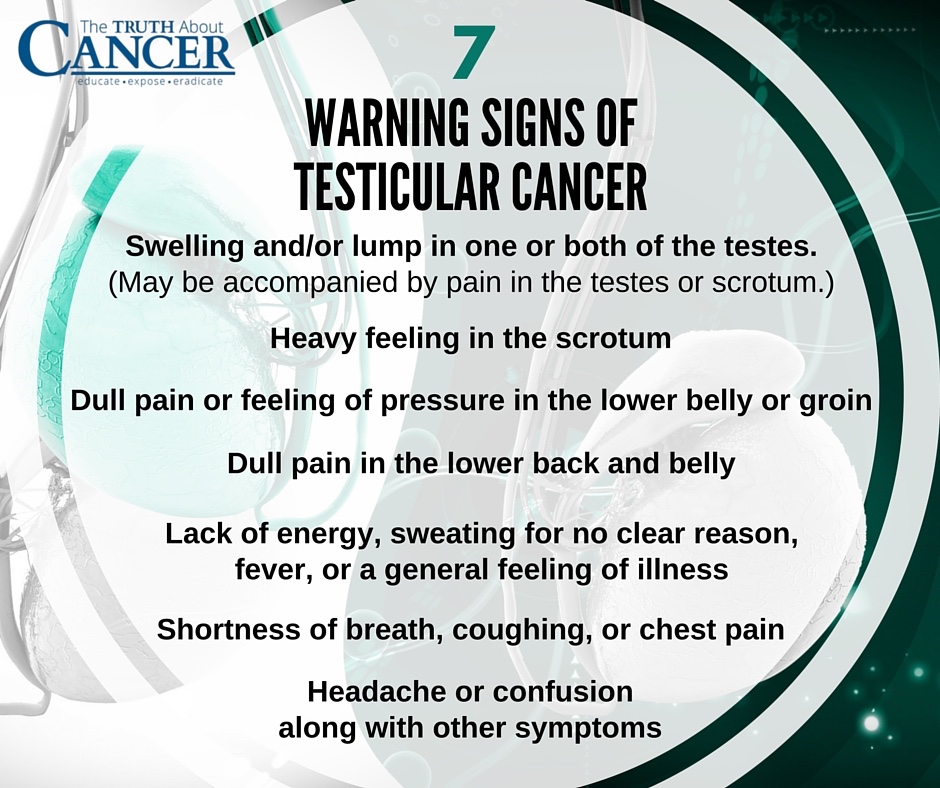
In a hurry? Click here to read the Article Summary...
Testicular cancer is a highly curable cancer that develops in the testicles. Located inside the scrotum, the testicles are a loose bag of skin underneath the penis and are part of the male reproductive system. Typically, this cancer develops in one or both testicles (the testes) in young men, but it can occur in older men as well and in rare instance, in younger boys. The odds for getting testicular cancer are estimated to be about 1 in 200, with about 80,000 cases being diagnosed each year in the United States alone. Although testicular cancer is considered to be rare, it is the most common cancer in American males between the ages of 15 and 35.
Knowing the signs of testicular cancer will help with early detection of the disease. The good news is that testicular cancer is notable for having among the highest cure rates among all cancers. It has an average five year survival rate as high as 99%, depending on how early the cancer is detected.
The even better news (especially for those who do not want to subject themselves to the dangers of chemotherapy or radiation) is that testicular cancer is also highly curable through natural alternative means. There are also several measures that can be taken to help avoid testicular cancer from developing in the first place.
The Two Kinds of Testicular Cancer
There are two main types of testicular cancer: seminomas and nonseminomas. These cancers grow from the germ cells that make sperm.
Seminoma
Seminoma is a slow-growing form of testicular cancer which is most often found in men in their 30s and 40s. The cancer is usually limited to just in the testes, but it can spread to the lymph nodes.
Nonseminoma
This more common type of testicular cancer tends to grow more quickly than seminomas. Nonseminoma tumors are often made up of more than one type of cell, and are identified according to these different cell types:
- Choriocarcinoma (rare)
- Embryonal carcinoma
- Teratoma
- Yolk sac tumor
A stromal tumor is a rare type of testicular tumor. They are usually not cancerous. The two main types of stromal tumors are Leydig cell tumors and Sertoli cell tumors. Stromal tumors usually occur during childhood.
7 Signs of Testicular Cancer
Common signs of testicular cancer include:
- A swelling and/or lump in one or both of the testes. There may or may not be pain in the testes or scrotum
- A heavy feeling in the scrotum
- A dull pain or feeling of pressure in the lower belly or groin
Sometimes these symptoms can be caused by other problems, such as a hydrocele or epididymitis.
Testicular cancer that has spread (metastasized) beyond the testicles and regional lymph nodes to other organs may cause other symptoms depending on the area of the body affected. Symptoms of late-stage testicular cancer may include:
- Dull pain in the lower back and belly
- Lack of energy, sweating for no clear reason, fever, or a general feeling of illness
- Shortness of breath, coughing, or chest pain
- Headache or confusion
Note that not all lumps on the testicles are tumors, and not all tumors are malignant (cancerous). There are many other conditions, such as testicular microlithiasis, epididymal cysts, and appendix testis (hydatid of Morgagni), which may be painful but are non-cancerous.
Testing for Testicular Cancer
A physical examination will typically reveal a firm lump (mass) in one of the testicles. When the health care provider holds a flashlight up to the scrotum, the light does not pass through the lump.
Other tests for testicular cancer include:
- Abdominal and pelvic CT scan
- Blood tests for tumor markers: alpha fetoprotein (AFP), human chorionic gonadotrophin (beta HCG), and lactic dehydrogenase (LDH)
- Chest x-ray
- Ultrasound of the scrotum
Causes of Testicular Cancer
The exact cause of testicular cancer is unknown. Anything that increases your chance of getting testicular cancer is a risk factor. Some of the top risk factors for testicular cancer include:
- Exposure to certain chemical toxins – Toxins are the top root cause of cancer
- Age – Most cases occur between the ages of 15 and 40, and testicular cancer is the type of cancer found most often in men ages 20 to 34
- Race – Caucasian men are 5 to 10 times more likely to develop testicular cancer than men of other races
- Family or personal history of testicular cancer – especially having an identical twin with testicular cancer
- Undescended testicle (cryptorchidism) in infants and young boys – Men with testicles that did not move down into the scrotum before birth are at increased risk. Men who had surgery to correct this condition are still at high risk of testicular cancer
- Abnormal testicular development
- Klinefelter’s syndrome – A sex chromosome disorder characterized by low levels of male hormones, sterility, breast enlargement, and small testes
- Human immunodeficiency virus (HIV) or AIDS
- Previous treatment for testicular cancer
- Viral infections of the testicles, such as occurs with mumps
- Injury to the scrotum
- Activity which may regularly put pressure on or irritate the scrotum (think cyclist Lance Armstrong)
It’s important to note that there is no known link between vasectomy and testicular cancer.
Testicular Cancer Prevention
Like all cancers, there are several steps one can take to help prevent testicular cancer. Such steps include:
- Addressing and eliminating the toxins, which are the root cause of most cancers, from your body and environment
- Building up your vital immune system − the body’s natural first line of defense against cancer and other illness
- Eating a very healthy, cancer-fighting, and immune boosting diet and avoiding unhealthy foods.
- Including a healthy lifestyle that includes regular exercise or physical activity, stress management, and plenty of regular direct and indirect sunshine
- Making sure that you get daily optimum nutrition through both diet and, as needed, supplementation. Note: Contrary to mainstream medical advice, optimum daily nutrition cannot be obtained from diet alone. As a matter of fact, it is almost impossible to even get minimal RDA amounts of the handful of vitamins and major minerals on the RDA list on a daily basis in a 2,000 to 2,500 calorie per day diet
- Paying special attention to cleansing, restoring, and protecting your vital liver − the body’s natural toxin removal organ. The great cancer pioneer Max Gerson observed that he never found a single cancer patient who did not also have an impaired liver
- Generally making your body as inhospitable to cancer as possible
Conventional Testicular Cancer Treatment
Mainstream medical treatment of testicular cancer depends on the type of testicular tumor and the stage of the tumor. Unlike other cancers, where sample cells are removed through a technique known as biopsy, doctors use a unique procedure when testicular cancer is suspected. The entire testicle is pulled up out of the scrotum through an incision in the groin and is examined under a microscope. The doctor can then determine if cancer is present, as well as the type of cancer cell − seminoma or nonseminoma.
After the presence and type of testicular cancer is determined, the next step is to determine how far the cancer has spread. This is called staging.
Stage I cancer has not spread beyond the testicle.
Stage II cancer has spread to lymph nodes in the abdomen.
Stage III cancer has spread beyond the lymph nodes (it could be as far as the liver, lungs, or brain).
Three types of conventional testicular cancer treatment are generally used.
Surgical treatment removes the testicle (orchiectomy), usually as soon as the presence of cancer is determined. Nearby lymph nodes may also be removed via a process known as lymphadenectomy.
Radiation therapy using high-dose x-rays or other high-energy rays may be used after surgery to prevent the tumor from returning. Radiation therapy is usually only used for treating the less common form of testicular cancer, seminomas. Seminomas are very sensitive to radiation therapy.
Chemotherapy uses drugs to kill cancer cells. This treatment has greatly improved survival for patients with both seminomas and nonseminomas. However, like radiation, chemotherapy has side effects which are not only unpleasant but which may lead to further problems, including second cancers, down the road.
Notably, both radiation and many chemotherapy drugs are themselves considered to be carcinogens − meaning that they can actually cause cancer.
Alternative Treatment for Testicular Cancer
Natural treatment for testicular cancer or any other type of cancer should incorporate all of the things one would usually do for cancer prevention and much more. It requires a comprehensive natural anti-cancer protocol which leaves no stone unturned. After all, even though testicular cancer is highly curable, it can nevertheless be fatal. When your very life is at stake you don’t want to go into the fight with only one or two bullets in your gun.
Take cancer fighting and immune boosting supplements such as oleander extract, turmeric, a potent medicinal mushroom supplement, inositol/IP6, colloidal silver, and more.
To discover more about steps to help ensure victory over cancer (including more detailed information about eliminating toxins and the other steps recommended above), see A Good Cancer-Fighting Foundation Will Ensure Victory Over Cancer.
We rely on health heroes like you to help us spread the word on this important, life saving information. Please share it with friends below.
Article Summary
- Although testicular cancer is considered to be rare, it is the most common cancer in American males between the ages of 15 and 35.
- The good news is that testicular cancer is highly curable through natural alternative means and measures can be taken to help avoid testicular cancer from developing in the first place.
- There are two main types of testicular cancer: seminomas and nonseminomas. These cancers grow from the germ cells that make sperm. A stromal tumor is a rare type of testicular tumor that is usually not cancerous.
- Common signs of testicular cancer include:
- A swelling and/or lump in one or both of the testes (There may or may not be accompanying pain in the testes or scrotum)
- A heavy feeling in the scrotum
- A dull pain or feeling of pressure in the lower belly or groin
- Symptoms of late-stage testicular cancer may include:
- Dull pain in the lower back and belly
- Lack of energy, sweating for no clear reason, fever, or a general feeling of illness
- Shortness of breath, coughing, or chest pain
- Headache or confusion
- Not all lumps on the testicles are tumors, and not all tumors are malignant (cancerous). Tests for testicular cancer include:
- Physical examination
- Abdominal and pelvic CT scan
- Blood tests for tumor markers: alpha fetoprotein (AFP), human chorionic gonadotrophin (beta HCG), and lactic dehydrogenase (LDH)
- Chest x-ray
- Ultrasound of the scrotum
- Like all cancers, there are several steps one can take to help prevent testicular cancer. Such steps include:
- Eliminating toxins from your body and environment
- Building up your vital immune system
- Eating a very healthy, cancer-fighting, and immune boosting diet and avoiding unhealthy foods.
- A healthy lifestyle that includes physical activity, stress management, and regular direct and indirect sunshine
- Getting optimal daily nutrition through both diet and supplementation as needed
- Paying special attention to cleansing, restoring, and protecting your liver
- Making your body as inhospitable to cancer as possible
[+] Sources and References

No comments:
Post a Comment